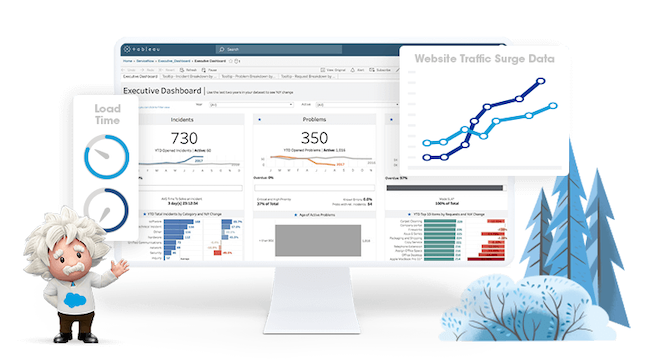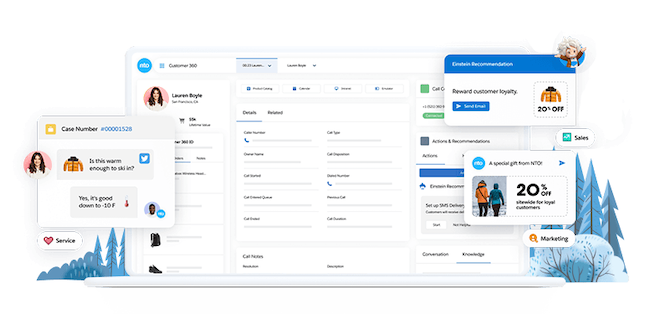The 2020 holiday season was the biggest one ever for digital sales which grew 50% YoY. This may not be surprising in a pandemic-fuelled climate. Nearly every customer became a digital-first shopper, but the long-term impact could be seismic.
Shoppers who were once committed to the in-person experience have now grown accustomed to the ease and convenience of a 24/7 online world. It’s hard to imagine them returning to brick-and-mortar shops with the same sense of dedication they once had.
For retailers, the importance of digital channel strategy has never been more evident. However, simply offering a digital experience is no longer enough. How can today’s businesses create a digital channel strategy to best engage customers during the holiday season? And how can they unite their channels to provide a seamless digital shopping experience?
Let’s look at three frequently asked questions about digital channels. We’ll then explore how retailers can create a digital channel strategy to provide customer experiences that exceed expectations.
What are digital channels used for?
Digital channels offer businesses a way to connect with their customers beyond physical stores. By engaging on digital channels, businesses can provide:
More relevant and personal communications
Highlight promotions
Build communities
Improve customer service
In other words, digital channels enable companies to build stronger relationships. Better yet, digital channels provide an omnipresence that extends beyond store hours.
What are the most common digital channels?
Some common digital channels include:
Websites and social media. Many social media channels have become virtual shopping malls, enabling users to shop directly in-app.
Voice technologies. Voice assistants are becoming more and more popular. There’s plenty of untapped potential in using them as a sales tool.
Online events. One of the consequences of the pandemic was the shift to more virtual events. These events offer a great way to build a community.
Email. The days of annoying spam are over. Today’s companies are using email to provide relevant info and add value to segmented customer groups.
Mobile apps, including messaging apps. In-app communication is a great tool but businesses need to respect users’ privacy and remain unobtrusive.
On-demand media, including music, video, and podcasts. Offering on-demand media helps businesses showcase their voice in a unique way.
Search engines. SEO still rules the digital world. Even on-demand media should be SEO-optimised to be discoverable.
Games, VR and AR. The idea of using AR and VR experiences for engaging with customers is still relatively untested. The possibilities of world-building should intrigue any forward-thinking business.
How can businesses create a digital channel strategy to engage visitors during the holiday season?
Connecting digital channels is one of the best ways to provide a smooth shopping experience. In fact, 76% of shoppers now expect consistent interactions across departments. By uniting touchpoints, businesses will find it easier to get a holistic overview of customer behaviour. They can offer better service as well as relevant and personalised communications to various audience segments.
Retailers may also want to create a digital channel strategy that integrates physical stores and enables them to provide new fulfilment options. This is especially relevant in a safety-first landscape. Retailers should offer click-and-collect and other pickup options.
How to build loyalty and grow your audience on digital channels
Digital channels help businesses engage with their audience at any time and any place. They enable businesses to reach out to new audience segments on their favourite channels. Businesses can use those channels to offer relevant communications and promotions.
Here are some ways that businesses can use digital channels to attract new customers and then keep them around for the long run.
- Get ahead of changing customer behaviour. The State of the Connected Customer report reveals that 58% of consumers expect to do more online shopping after the pandemic than before. And 88% expect businesses to accelerate their digital initiative.
- Leverage tools to track and engage with audience segments on their favourite channels, including social media. The Connected Customer report shows that 76% of shoppers use different channels depending on context.
Grow your audience. The pandemic changed the way that people shopped and what they shop for. In the new normal, people are emerging from isolation and swapping comfy sweats for luxury items. Sporting goods also saw a boom last holiday season (108% YoY). People stayed out of the gym and powered-up from home. Capitalise on changing customer behaviour by building segments around demographic information, purchase history, and digital preferences.
Optimise your digital channel strategy. After creating new audience segments, look at how you can build a strategy to engage these segments on their favourite channels. Analyse how your business can best use the strengths and weaknesses of each channel. Then, form an omnichannel strategy that leverages those strengths and offers consistent messaging across touchpoints.
Refine your SEO strategy. The new normal means new concerns and search terms. Make sure that your business is easily discoverable by optimising your SEO strategy to keep up with the current moment. Tools like Answer the Public, Google Trends, and Google Keyword Planner can help you stay ahead of the search-traffic curve.
Level-up your loyalty programme. The digital revolution has led to an increased focus on driving customer loyalty. Considering a business’s competitor is always just a click away. Make sure that you have an effective loyalty programme in place. We found that 78% of customers are more likely to make purchases from brands with loyalty programmes.
Step into the new age of service. As more and more customers turned to digital channels, their expectations for service changed. Today, good is no longer good enough. Customers have come to expect exceptional experiences. Consider implementing a customer-centric solution like Service Cloud to empower your team and provide an end-to-end digital experience.
Use AI to turbocharge your promotions. It’s never been easier for customers to shop around for the best deal. It can be done in just a few clicks. And while it’s important to offer competitive prices, businesses don’t want to get caught up in a battle of lower, lower, lowest. Instead, leverage smart AI tools like Einstein to analyse shopping preferences and buyer behaviour. Then, deliver the right promotion to the right customer at the right time.
6 ways to update your digital channels in time for the holiday season
The 2021 holiday season is coming up quickly. If your business hasn’t yet formed a digital channel strategy, the time to act is now. And if you’ve already implemented a digital channel strategy, then make sure to update your digital channels before the shopping season arrives. Some ways to optimise your channels for the season include:
Connect marketing, service, and commerce channels to provide a smoother customer experience and drive brand loyalty.
Enable social commerce to engage with customers who prefer to shop on Facebook, Instagram, and TikTok. These channels saw a 500+% increase in shopping during the pandemic.
Consider hosting virtual events to launch products and services, showcase goods, and build relationships. These events can also be used to drive people back into the store. Especially when tied to promotional offers.
Make sure that your mobile experience is hassle-free. Customers are quick to click away from substandard mobile experiences. In fact, studies of Q3 in 2020 revealed that mobile had an 88% cart abandonment rate.
Use conversational commerce for quick and easy conversions. By using messaging channels like Facebook Messenger and WhatsApp, you can converse with customers in the channels they use the most.
Provide service across your digital channels, including online chat, messenger apps, and video. Leverage cloud technology to provide reps with data from customers’ previous interactions. You can use Service Cloud Voice to transcribe calls and surface recommendations.
Turbocharge your digital channel strategy by augmenting the in-store experience
It’s evident that we’re firmly in the digital age. However, that doesn’t mean the store should be neglected. It just needs to be reimagined. By including the store in your digital channel strategy, you can highlight its strengths:
Tactile experiences
In-person service
Ability to showcase sales
While minimising the potential challenges:
Stock issues
Capacity concerns
You can also add digital to provide flexible options that prioritise safety. This includes curbside pickup, virtual concierges, and click-and-collect.
One of the most challenging aspects of ecommerce is handling returns. With 30% of online purchases expected to be returned, retailers need to offer convenient and efficient ways to process them.
By leveraging digital channels, businesses can offer virtual support for products. As a result, they can potentially avoid the need to return an item in the first place. And if an item bought online needs to be returned, it can be done through contactless return kiosks. Thus, avoiding shipping costs while prioritising safety.
Additionally, businesses can use the power of digital channels to deliver relevant recommendations and promotional offers straight to the mobiles of in-store holiday shoppers, boosting revenues and increasing loyalty.
Is your business’s digital channel strategy ready for the holiday season?
There’s no denying that things have changed drastically. The 2020 holiday season was like no other in recent memory. Some businesses have created a new digital channel strategy to succeed in the current climate. Others are still playing catch up.
Expectations for customer service are sky high. And seamless omnichannel journeys are standard. In other words, retailers need a new playbook.
As more shoppers return to brick-and-mortar stores, hybrid experiences should only grow more popular. Customers should have the option to:
Shop within their favourite social media channels
Chat to service via video
Attend in-store launch parties and workshops
Make purchases without leaving their car
The shopping experience has never been so flexible. But in order to seize the moment and create new and exciting retail models, businesses must have an innovative digital channel strategy centred around the customer.
We want to help businesses prepare for the 2021 holiday season and optimise their digital channel strategy. So we’ve put together a free guide to getting started. Download the New Holiday Retail Panning Guide today!










